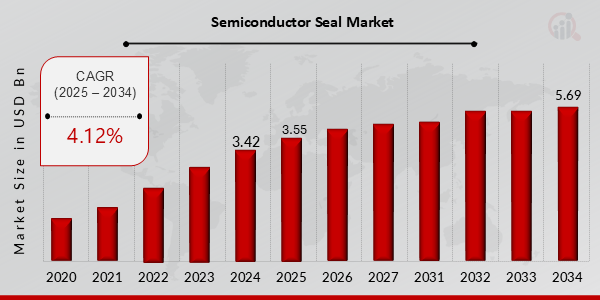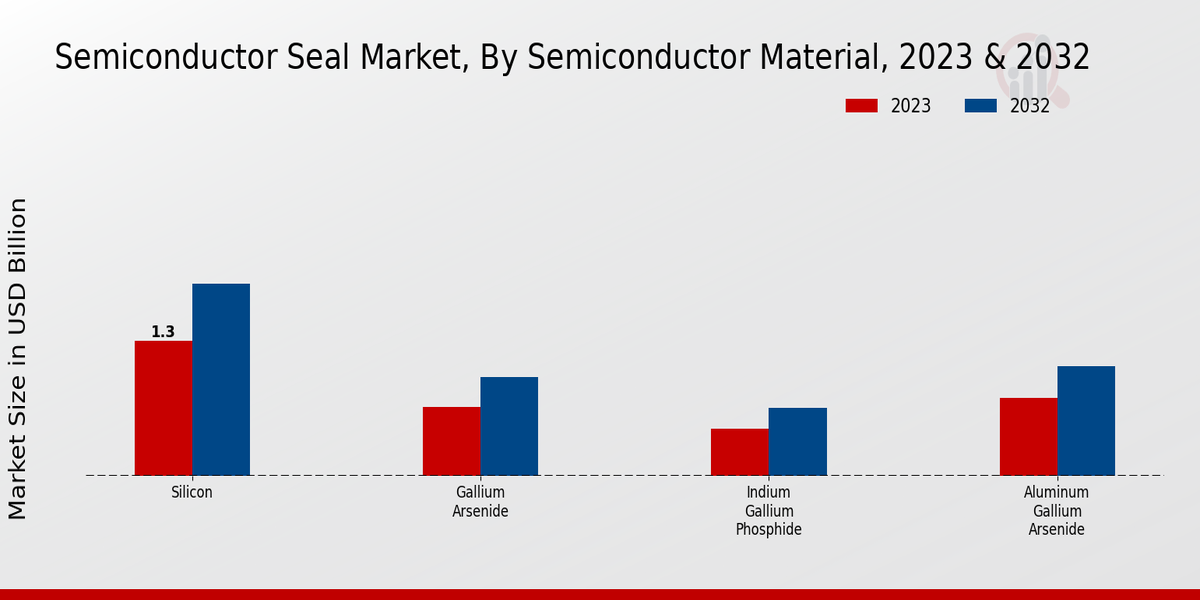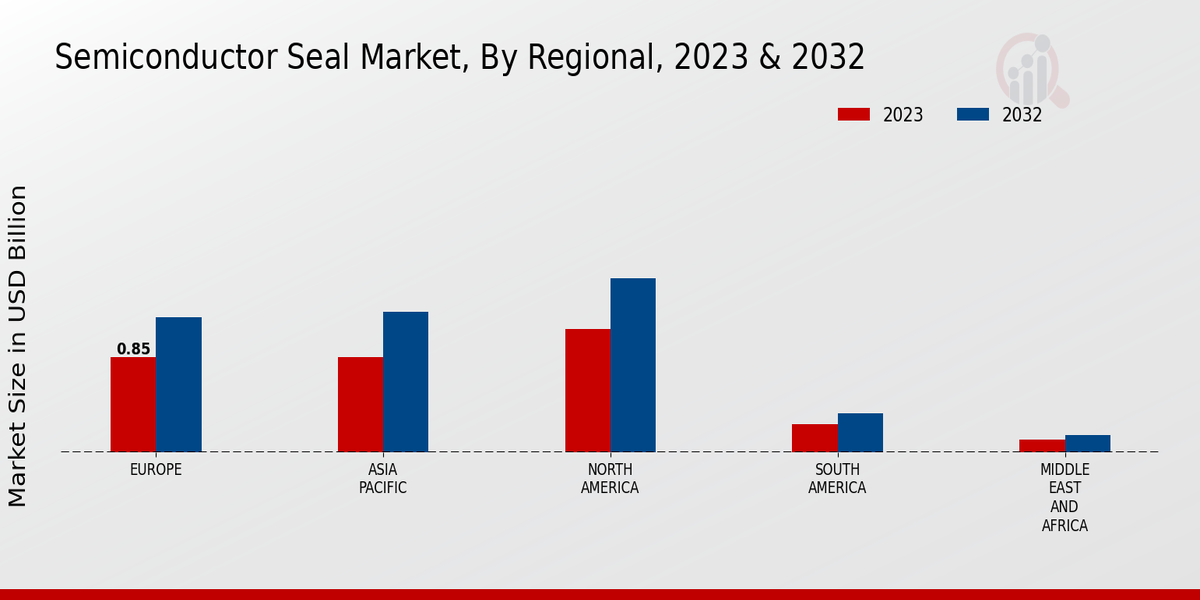Global Semiconductor Seal Market Overview
Semiconductor Seal Market Size was estimated at 3.42 (USD Billion) in 2024. The Semiconductor Seal Market Industry is expected to grow from 3.55 (USD Billion) in 2025 to 5.69 (USD Billion) till 2034, exhibiting a compound annual growth rate (CAGR) of 4.12% during the forecast period (2025 - 2034).
Key Semiconductor Seal Market Trends Highlighted
Key market drivers for the semiconductor seal market include the increasing demand for semiconductor devices in various end-use industries, such as automotive, consumer electronics, and healthcare. The rising adoption of advanced packaging technologies, such as fan-out wafer-level packaging (FOWLP) and system-in-package (SiP), is also driving the demand for semiconductor seals. Additionally, the growing trend toward miniaturization and integration of electronic devices has led to a need for more compact and reliable sealing solutions. Opportunities in the semiconductor seal market can be found in the emerging markets for electric vehicles, 5G networks, and wearable devices.
The adoption of advanced materials and technologies, such as low-k dielectrics and high-density interconnects, is also presenting opportunities for market growth. Furthermore, the increasing focus on sustainability and environmental regulations is creating opportunities for semiconductor seals that meet these requirements. Recent trends in the semiconductor seal market include the development of low-stress and hermetic seals to meet the demands of advanced packaging technologies. The use of novel materials, such as graphene and carbon nanotubes, is also gaining traction as these materials offer superior electrical, thermal, and mechanical properties.
Additionally, the integration of sensors and monitoring capabilities into semiconductor seals is emerging as a promising trend, enabling real-time monitoring of device performance and environmental conditions.

Source: Primary Research, Secondary Research, MRFR Database and Analyst Review
Semiconductor Seal Market Drivers
Rising Demand for Advanced Semiconductor Devices
The growing adoption of advanced semiconductor devices, such as those used in artificial intelligence (AI), machine learning (ML), and high-performance computing (HPC), is driving the demand for semiconductor seals. These devices require reliable and high-performing seals to protect sensitive components from harsh operating conditions. Semiconductor seals play a critical role in ensuring the long-term reliability and functionality of these advanced devices, contributing to the overall growth of the Semiconductor Seal Industry.
Expansion of Semiconductor Manufacturing Facilities
Semiconductor Seal Market Industry Introduction According to a new report from the Wafer News on Semiconductor Seal Industry, the global semiconductor industry is currently in a period of major expansion, with large-scale new investments into manufacturing. These investments are largely driven by increased demand for the product across end-use industries. The seal, which requires specialized materials and equipment for manufacturing, is a critical component of any fabrication plant. Thus, the growth in the manufacturing of these semiconductors is likely to present new opportunities for market players in this segment of the market.
Government Initiatives and Policies
The semiconductor industry is gaining attention from governments across the world. Various governmental policies, such as subsidies, tax benefits, and R funding, benefit the semiconductor industry. Government support is essential for the growth of the semiconductor market. This can be vital at every stage of development, including the creation of high-quality semiconductor seals and their production. These practices provide a beneficial business environment for market participants in the Semiconductor Seal Market.
Semiconductor Seal Market Segment Insights
Semiconductor Seal Market Semiconductor Material Insights
The Semiconductor Seal Market, particularly within the Semiconductor Material segment, has shown steady growth, reflecting the increasing demand for technological advancement and innovation. In 2023, the overall market value reached 3.16 USD Billion, expected to grow significantly, with the market being valued at 4.5 USD Billion by 2032. The rise can be attributed to a variety of factors, including the proliferation of electronics, advancements in artificial intelligence, and the growing automotive and telecommunications sectors driving the need for semiconductor solutions.
A significant portion of the market revenue comes from various materials, including Silicon, Aluminum Gallium Arsenide, Indium Gallium Phosphide, and Gallium Arsenide, showcasing diverse applications across multiple industries. Among these, Silicon stands out prominently as a major player, valued at 1.3 USD Billion in 2023, with expectations to increase to 1.85 USD Billion by 2032. Its characteristics, such as abundance, affordability, and excellent electrical properties, make it the cornerstone of the semiconductor industry, solidifying its majority holding position.
This material is extensively used in electronic components, integrated circuits, and a range of consumer electronics, which further enhances its significance within the market. Aluminum Gallium Arsenide follows as another noteworthy segment, valued at 0.75 USD Billion in 2023 with projected growth to 1.05 USD Billion by 2032. This material is primarily utilized in high-frequency and optoelectronic applications, including laser diodes and solar cells. Its unique properties make it highly sought after, emphasizing the sector's growth potential in optoelectronic devices.
Indium Gallium Phosphide, while a smaller segment valued at 0.45 USD Billion in 2023 and estimated to reach 0.65 USD Billion by 2032, holds a specific niche in the market as it’s instrumental in producing high-efficiency solar cells and high-speed devices. This material plays a pivotal role in enhancing device performance and efficiency, creating opportunities for growth within specialized applications.
Gallium Arsenide has also established itself as a vital component of the semiconductor landscape. Valued at 0.66 USD Billion in 2023 with projected growth to 0.95 USD Billion by 2032, this material's advantages in high-speed electronics and its application in the production of RF components and integrated circuits underline its importance. Gallium Arsenide dominates in niche markets requiring high performance and power efficiency, particularly in communication technologies.
The Semiconductor Seal Market segmentation within the Semiconductor Material category reflects the inherent diversification of the industry, responding to the evolving technology landscape and the need for specialized materials to address complex engineering challenges. Each material underlines the market's resilience and capacity for growth, driven by technological advancements and innovation, while the varied application across multiple sectors ensures integral development in the upcoming years.

Source: Primary Research, Secondary Research, MRFR Database and Analyst Review
Semiconductor Seal Market Packaging Type Insights
The Semiconductor Seal Market revenue in 2023 is projected to reach 3.16 billion USD, reflecting the growing demand for various sealing solutions within the semiconductor industry. The market comprises several packaging types, which are essential for both performance and reliability. Among these, Metallic Seals are notable for their durability and robustness in demanding environments, making them a preferred choice for many applications. Ceramic Seals cater to high-temperature conditions and corrosive environments, ensuring extended life cycle and performance stability.
Glass Seals provide hermeticity essential for sensitive electronic components, while Polymer Seals are increasingly popular due to their versatility and cost-effectiveness, accommodating diverse application needs. The Semiconductor Seal Market segmentation illustrates a balanced distribution among these types, highlighting their respective roles in enhancing product reliability and efficiency. This market is driven by technological advancements, increasing demand for miniaturized components, and the expanding consumer electronics sector, alongside challenges such as material compatibility and rising raw material costs, which presents both risks and opportunities for stakeholders in the global semiconductor landscape.
Semiconductor Seal Market End Use Insights
The Semiconductor Seal Market is projected to be valued at 3.16 USD Billion in 2023, reflecting its significance in various applications. In the context of End Use, the market encompasses several key sectors, including Automotive, Electronics, Power, Telecommunications, and Medical. The Electronics sector is vital, driven by the high demand for consumer electronics and the continuous push for innovation in integrated circuits. The Automotive segment is also noteworthy, as advancements in vehicle technology increasingly rely on semiconductor components for functionality and safety features.
The Power industry benefits from semiconductor seals used in energy-efficient systems, while Telecommunications sees growth due to the expansion of communication networks requiring robust sealing solutions. The Medical sector, focusing on precision and reliability, relies on semiconductor seals to ensure compliance with safety and performance standards. Overall, the diverse applications of semiconductor seals highlight their critical role across industries, contributing to the Semiconductor Seal Market revenue and supporting its growth trajectory as technology continues to evolve.
The market growth is further fueled by the increasing adoption of IoT devices, along with ongoing innovations within the realms of automation and smart devices.
Semiconductor Seal Market Hermeticity Level Insights
The Semiconductor Seal Market, valued at 3.16 USD Billion in 2023, is witnessing notable advancements driven by the Hermeticity Level segment. Within this segment, the need for effective sealing solutions remains critical as they are paramount to ensure the reliability and performance of semiconductor devices. The Ultra-High Vacuum, High Vacuum, Medium Vacuum, and Low Vacuum classifications cater to various industrial applications, making them increasingly significant in the market landscape. Ultra-hhigh vacuum, for instance, is essential for environments that require minimal gas presence, thereby supporting high-performance semiconductor technologies.
High Vacuum solutions find extensive use in the production of microelectronics, while Medium and Low Vacuum options are suitable for less stringent applications. The consistent demand across these Hermeticity Level categories signals strong market growth potential as manufacturers look to innovate and enhance sealing technologies to meet evolving industry standards. Growth drivers include the increasing reliance on advanced semiconductor applications and the need for stricter quality control measures. Challenges such as material compatibility and production costs present opportunities for innovation, further driving the Semiconductor Seal Market revenue.
As the market evolves through 2032, the segmentation offers a comprehensive understanding of the trends and dynamics shaping the Semiconductor Seal Market statistics.
Semiconductor Seal Market Assembly Method Insights
The Semiconductor Seal Market is projected to achieve a valuation of 3.16 USD Billion in 2023, reflecting the importance of assembly methods within this industry. The Assembly Method segment plays a crucial role in the semiconductor packaging process, with techniques like Die Bonding, Wire Bonding, and Flip Chip driving significant advancements. Die Bonding, known for its efficiency in attaching the die to the substrate, caters to the rising demand for compact and high-performance semiconductor devices. Wire Bonding remains a dominant technique owing to its cost-effectiveness and ease of implementation, making it a preferred choice among manufacturers.
Flip Chip technology is gaining attention as it allows for higher interconnect density and improved thermal performance, aligning with trends towards miniaturization and increased functionality in electronics. The market is benefiting from growing applications across consumer electronics, automotive, and telecommunications, as well as innovations aimed at enhancing productivity and performance. Consequently, the Semiconductor Seal Market is positioned well for continued growth, fueled by diverse assembly methods, each contributing uniquely to the industry's evolution.
Semiconductor Seal Market Regional Insights
The Semiconductor Seal Market exhibits a diverse landscape across various regions, with a total valuation of 3.16 USD Billion in 2023. North America leads this regional segmentation, significantly dominating the market at 1.1 USD Billion in 2023, reflecting its strong foothold in technology and manufacturing. Europe follows with a valuation of 0.85 USD Billion, showing significant growth potential driven by advancements in semiconductor technologies. The Asia Pacific region also plays a key role, worth 0.85 USD Billion, benefitting from rapid industrialization and increasing demand for electronics.
South America, with a valuation of 0.25 USD Billion, and the Middle East and Africa, at 0.11 USD Billion, represent the smaller markets but highlight emerging growth opportunities as these regions develop their technological infrastructure. Overall, the Semiconductor Seal Market statistics indicate a balanced yet competitive regional structure, with North America and Europe accounting for the majority holding while Asia Pacific is positioned for substantial expansion due to its growing economies and consumer markets. As the market evolves, enhancing regional capabilities could unlock further opportunities and optimize the Semiconductor Seal Market revenue across all areas.

Source: Primary Research, Secondary Research, MRFR Database and Analyst Review
Semiconductor Seal Market Key Players And Competitive Insights
Major players in the Semiconductor Seal Market industry are constantly striving to gain a competitive edge by introducing innovative products and expanding their global reach. Leading Semiconductor Seal Market players are focusing on strategic partnerships, acquisitions, and collaborations to strengthen their market position. The Semiconductor Seal Market development is driven by the increasing demand for semiconductor devices in various end-use industries, such as automotive, consumer electronics, and industrial automation. Competitive Landscape is expected to remain dynamic, with new entrants and established players vying for market share. Tokyo Electron Limited is a leading company in the Semiconductor Seal Market.
The company offers a wide range of semiconductor manufacturing equipment, including semiconductor seals. Tokyo Electron has a strong global presence and a well-established customer base. The company's commitment to innovation and customer satisfaction has contributed to its success in the Semiconductor Seal Market. Tokyo Electron is expected to continue to play a significant role in the market in the coming years.
A competitor company in the Semiconductor Seal Market is Entegris, Inc. The company offers a comprehensive portfolio of semiconductor manufacturing materials, including semiconductor seals. Entegris has a strong focus on research and development, and it is known for its innovative products. The company has a global presence and a diverse customer base. Entegris is expected to continue to be a strong competitor in the Semiconductor Seal Market in the future.
Key Companies in the Semiconductor Seal Market Include
- Rutronik Elektronische Bauelemente
Semiconductor Seal Industry Developments
The Semiconductor Seal Market is projected to reach USD 4.5 billion by 2032, exhibiting a CAGR of 4.01% during the forecast period (2024-2032). Rising demand for semiconductor devices in various end-use industries, including consumer electronics, automotive, and industrial, is driving market growth. Technological advancements and miniaturization trends in semiconductor devices are also contributing to the increasing need for reliable and effective sealing solutions. Key market players are focusing on developing innovative seal designs and materials to meet the evolving requirements of the semiconductor industry.
Recent developments include the introduction of low-outgassing materials, hermetic seals, and advanced sealing techniques to enhance device performance and reliability. Strategic collaborations and acquisitions among market participants are also shaping the competitive landscape.
Semiconductor Seal Market Segmentation Insights
-
Semiconductor Seal Market Semiconductor Material Outlook
- Aluminum Gallium Arsenide
-
Semiconductor Seal Market Packaging Type Outlook
-
Semiconductor Seal Market End Use Outlook
-
Semiconductor Seal Market Hermeticity Level Outlook
-
Semiconductor Seal Market Assembly Method Outlook
-
Semiconductor Seal Market Regional Outlook
| Report Attribute/Metric |
Details |
|
Market Size 2024
|
USD 3.42 Billion
|
|
Market Size 2025
|
USD 3.55 Billion
|
|
Market Size 2034
|
USD 5.69 Billion
|
|
Compound Annual Growth Rate (CAGR)
|
4.12% (2025-2034)
|
| Report Coverage |
Revenue Forecast, Competitive Landscape, Growth Factors, and Trends |
|
Base Year
|
2024
|
|
Market Forecast Period
|
2025-2034
|
|
Historical Data
|
2020-2023
|
| Market Forecast Units |
USD Billion |
| Key Companies Profiled |
WPG Holdings, Arrow Electronics, RS Components, Farnell, AsiaPac Technologies, DigiKey Electronics, Avnet, Mouser Electronics, TTI, Altium, Cadence Design Systems, Future Electronics, Astute Electronics, Rutronik Elektronische Bauelemente |
| Segments Covered |
Semiconductor Material, Packaging Type, End Use, Hermeticity Level, Assembly Method, Regional |
| Key Market Opportunities |
Increasing demand for consumer electronics growth in the automotive industry, technological advancements, rising adoption of 5G technology, expansion of the semiconductor industry |
| Key Market Dynamics |
Increasing demand for semiconductors Technological advancements Rising adoption of IoT devices Growing automotive industry Government initiatives for semiconductor development |
| Countries Covered |
North America, Europe, APAC, South America, MEA |
Frequently Asked Questions (FAQ):
The Semiconductor Seal Market is expected to be valued at 5.69 USD Billion in 2034.
The expected CAGR for the Semiconductor Seal Market from 2025 to 2034 is 4.12%.
The North American Semiconductor Seal Market is expected to be valued at 1.55 USD Billion in 2032.
Silicon is projected to be valued at 1.85 USD Billion in the Semiconductor Seal Market by 2032.
The Asia Pacific region is projected to grow to 1.25 USD Billion in the Semiconductor Seal Market by 2032.
Aluminum Gallium Arsenide is expected to be valued at 1.05 USD Billion in 2032.
Key players include WPG Holdings, Arrow Electronics, RS Components, and Mouser Electronics, among others.
Gallium Arsenide is projected to reach a market value of 0.95 USD Billion in 2032.
Indium Gallium Phosphide is expected to be valued at 0.65 USD Billion in 2032.
Challenges include supply chain disruptions and fluctuating raw material prices impacting overall growth in the market.














